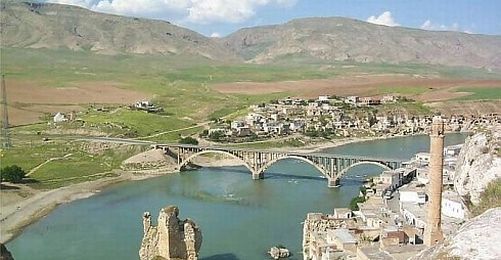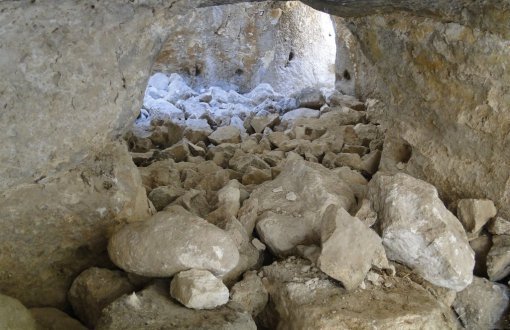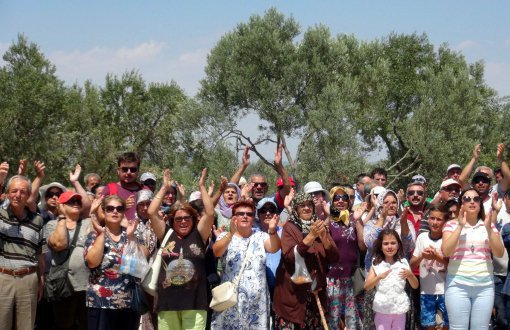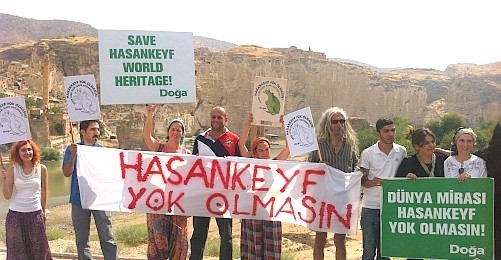
Forestry and Waterworks Minister Veysel Eroğlu and Finance Minister Mehmet Şimşek met with protests from the Initiative to Sustain Hasankeyf and the Nature Association during a visit they paid to the ancient city of Hasankeyf, a settlement dating back to at least 12,000 years ago and which is to be inundated under the Ilısu Dam Reservoir.
Minister Eroğlu and Şimşek claimed the Ilısu Dam represented "an opportunity to save Hasankeyf" which would turn into a center of attraction and tourism. "A father would not bestow his son with such a [gift] as this," they said.
"Villagers riding jet skis over the reservoir"
"We told them for years to come over here, see this open air museum and breathe its air before making a decision," said Ömer Faruk Akyüz, a member of the Initiative to Sustain Hasankeyf.
The occasion marks the very first time Minister Eroğlu has come to visit the town.
Hasankeyf is the only place in the world that meets nine of the ten criteria set forth by the UNESCO World Heritage Center, and nothing would justify its inundation, Akyüz said.
"The government is yet to explain to us how the historical structures here are going to be moved. They should stop accusing us of being against development and the dam. Let them come here and discuss with non-governmental organizations (NGOs) and the locals about how we are going to save Hasankeyf and carry it into the future," he added.
"They talk about doing water sports over the reservoir and the kilowatts per hour the dam will provide. They could hardly be any further than seeing the people's reality. Are the villagers here supposed to ride jet skis over the reservoir?" Akyüz said.
68 percent of locals do not want to abandon Hasankeyf

Archeological excavations have revealed only this week that the town's history goes back to12,000 years ago, in addition to the discovery of a water purification system left by the Artuklu in the 12th century A.D.
Officials diverted the waters of River Tigris which began flowing from tunnels on Thursday for the first time after a thousand years.
The waters are set to rise about 40 meters, and a new town is to be built over the mountain slope across. Officials are planning to lend money to the displaced locals to get them to move into these homes built by the Housing Development Administration of Turkey (TOKİ,) and the construction is already underway.
The area in which the Ilısu Dam is going to be built contains a total of 289 archeological conservation sites, including Hasankeyf, even though only 40 percent of this area has actually been subjected to a surface survey. That figure is expected to double, if that survey can be completed.
Hasankeyf is renowned for a stone bridge that was once the biggest of its kind, the El Rizk Mosque, the Zeynel Bey Shrine and Baths, around 6,000 caves and particularly for its fortress over the rocks.
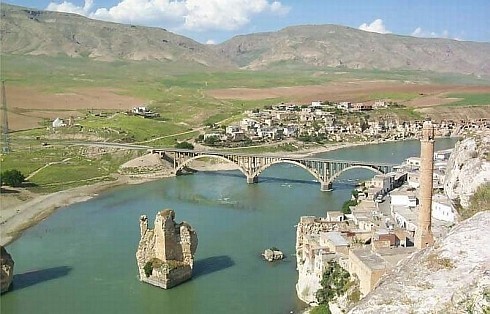
Studies show that 68 percent of locals do not want to abandon Hasankeyf. The project will affect around 55,000 people from 199 villages in the southeastern provinces of Batman, Siirt, Diyarbakır, Mardin and Şırnak. That figure reaches 80,000 with other locals who were forced to emigrate during the conflict between government forces and the Kurdistan Workers' Party (PKK) in the 1990s.
123 bird species were spotted only in Hasankeyf and a 12 kilometer long area to its west, not to mention the endangered Euphrates turtles.
The impact of the dam is expected to be sweeping and will result in the destruction of the habitats and food sources of endangered species, an increase in waterborne diseases such as malaria, and a reduction in the quality of water. (NV)





